Hurricane Melissa Recovery Effort
Air Date: Week of November 7, 2025

Heavy flooding in Mayarí, Holguín after Hurricane Melissa hit Cuba as a major Category 3 storm on October 29th. (Photo: Courtesy of José Luis Tan)
As one of the strongest hurricanes ever documented in the Atlantic, Hurricane Melissa brought catastrophic damage to Jamaica and Cuba, and an extensive relief and recovery effort is now underway. Marianna Kuttothara is Head of Health, Disaster, Climate and Crisis for the Americas at the International Federation of Red Cross and Red Crescent Societies and joins Host Jenni Doering to talk about the aid efforts, long road to recovery, and importance of building back better.
Transcript
CURWOOD: It’s Living on Earth, I’m Steve Curwood.
DOERING: And I’m Jenni Doering.

Makare Barnes works as a butler at Sandals South Coast in White House, Jamaica. A tree fell on his house in Westmoreland while he was waiting out the storm inside. (Photo: Courtesy of Makare Barnes)
The climate crisis made Hurricane Melissa worse in every aspect, according to scientists at World Weather Attribution. The rapid intensification, prodigious rainfall, and blistering winds were all fueled by warmer than normal air and ocean water, conditions that climate disruption makes six times more likely. The storm was a catastrophic Category 5 with 185 mile an hour winds when it made landfall in Jamaica and for the people there it was a very long and harrowing night. Makare Barnes lives in Westmoreland Parish on the hard-hit West Coast of Jamaica and heard trees snapping all around.
MAKARE: There's nothing you can do. You're just hoping that none falls on your house, which it did. My neighbor tree fell on mine. But we’re safe and sound.
DOERING: Makare works at a resort near the town of Black River, which was almost totally destroyed, and many of his coworkers lost their homes after the ferocious wind ripped their roofs right off.
MAKARE: They told me like they hear the whistling. And then the roof just -- [SNAPS FINGERS] -- went away. Just went up.
DOERING: By the time the storm got to Cuba the wind speed had slowed to 120 miles an hour, but it was still a major Category 3 hurricane causing extensive damage. And the rain absolutely poured down. With the relief and recovery effort now underway, to learn more especially about the situation in Cuba we’re joined by Marianna Kuttothara, Head of Health, Disaster, Climate and Crisis for the Americas at the International Federation of Red Cross and Red Crescent Societies. So Marianna, can you walk us through the steps taken to assist in the immediate aftermath of this storm?

Marianna Kuttothara, Head of Health, Disaster, Climate and Crisis for the Americas at the International Federation of Red Cross and Red Crescent Societies. (Photo: Courtesy of IFRC)
KUTTOTHARA: Yeah, I can say, well, the first thing is to check that everyone's okay. Immediately, the priorities were to send teams to see what the situation was, provide food, water, shelter. So Jamaica Red Cross was also helping manage shelters in the immediate aftermath. And Cuban Red Cross as well, they not only supported with preventive evacuations, but also there were evacuations that were happening right after to prevent people from being in further distress. One of the key needs that's emerging both in Cuba and Jamaica, and was probably one of the first actions, was also providing mental health and psychosocial support. So both Jamaica and Cuba are, unfortunately not strangers to hurricanes. We see that Melissa is hitting Jamaica just 16 months after Hurricane Beryl, and in Cuba, Melissa is striking just a year after Hurricane Oscar, right? So this level of catastrophe and damage also brings a lot of trauma and need for not just the physical well-being, but also the mental health support.
DOERING: Where did hurricane Melissa hit Cuba hardest? And what is it like in those areas right now?
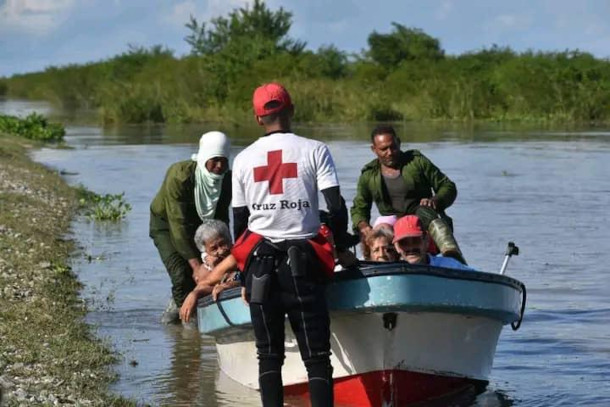
The Cuban Red Cross helped rescue hundreds of stranded people when the Cauto River flooded in the wake of Hurricane Melissa. (Photo: Courtesy of IFRC)
KUTTOTHARA: So hurricane Melissa hit Cuba on the eastern side of Cuba, it actually made landfall in Santiago de Cuba. And I want to again highlight that this were areas that had been just a year ago affected by Hurricane Oscar. But there is also arbovirus outbreak that had been declared. So that's like dengue, chikungunya and other vector carrying diseases, or puche is another one. So this is a compounded disaster, so to speak, right? Part of the reason why it's hard to get as much information as connectivity, right? So power outages were already a challenge, and even more so now. But similarly, there are situations where communities have been cut off because of landslides and access, or just poor road conditions, houses that are quite destroyed, if not completely destroyed, health needs that were already existing, but also access to safe water is a challenge. And then there's also concern about just health issues being further exacerbated, the existing health issues now that there's standing water and these vector borne diseases are likely to proliferate.
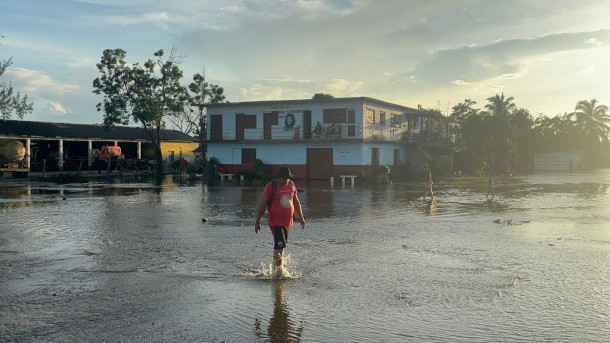
Extensive flooding in the province of Granma has destroyed property and crops, leaving many people homeless. (Photo: Courtesy of IFRC)
DOERING: Can you tell us what you've heard about someone in Cuba who is actually there?
KUTTOTHARA: Yeah, we have a colleague who is based in our Santo Domingo office who is currently in Cuba. He traveled in the immediate aftermath, and he was telling us, yeah, precisely this, just seeing the trauma in people's faces, the despair, the need for support. I think sometimes we also focus on just the sadness of the situation. But he was also impressed by the incredible work that the Cuban Red Cross is doing, immediately mobilizing, helping communities, coordinating with local authorities and other community organizations to take people out of their homes, ensure that they're provided with essential relief items.
DOERING: And I understand that the recovery effort that the Red Cross is embarking on, you're looking at 24 months of doling out this aid. I mean, I know it takes a long time to recover from this kind of a disaster. Why does it take so long for people to get back on their feet?

Recovery efforts are well underway in Jamaica, where Red Cross volunteers work with those whose homes sustained heavy damage in Hurricane Melissa. (Photo: Courtesy of IFRC)
KUTTOTHARA: Yeah, I would say that there's kind of two phases, right, the relief phase, as we say, which is the immediate needs and then, as you rightly mentioned, the recovery, right? And recovery is not just about surviving, right? It really is about being in a better state. And I would even say making sure that people are thriving. And unfortunately, we can't say no other hurricane is going to affect Jamaica or Cuba. We know this might happen again. It might even happen, we're still not out of the hurricane season, so it's about building community resilience, right? And how can we better prepare for a future disaster of this magnitude. For example, in Jamaica, part of the recovery efforts include strengthening existing community disaster response teams or creating or reactivating new ones. And why? Because the communities are obviously the first ones affected, but the first ones to respond themselves right. Making sure that communities prepare for these type of disasters and they can do things to potentially mitigate the risks. That includes things like nature-based solutions. Typically, one of the examples referenced is planting mangroves to reduce the impact of storm surge in coastal communities, or in terms of shelter and the reconstruction we don't just want people to patch up their houses, but really what we call “build back better,” that means using better material, improved construction techniques that take into account these potential disasters.
DOERING: And on that note, how important is it for aid efforts to be incorporating the climate crisis? How important is it to be thinking about our future here?

Makare’s home after a tree fell on it during Hurricane Melissa, which also wiped out all of the fruit trees in his yard. (Photo: Makare Barnes)
KUTTOTHARA: Yeah, I would say it's critical. I think, you know, recovery and resilience need to be part of our just a continuous investment and not one offs. We're seeing quicker intensification of storms like Melissa and we're experiencing just more and more disasters, right? So our capacity to just operate on, just solely thinking or solely acting on just a quick relief phase is going to be stretched, and we're also seeing that the scale of needs is increasing, but the financing is not necessarily increasing that proportion. So we have to think about, how do we invest smartly? And investing smartly means making sure that we are better prepared and building that resilience.
DOERING: Marianna, before you go, amid this very difficult situation for many people in the Caribbean, what gives you hope?
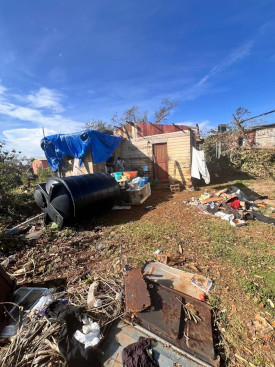
Hurricane Melissa hit the southwest of Jamaica as a Category 5 storm with winds over 185mph. The storm, which left more than 70% of the island without power, caused extensive damage to homes and infrastructure. (Photo: Makare Barnes)
KUTTOTHARA: I think what gives me hope is seeing how quickly people are just readying themselves to support, and this comes at different levels, immediately after the passage of Melissa in both Jamaica and Cuba, the teams reached out. We reached out to them, and we were talking, for example, with Jamaican Red Cross colleagues who were under a tree trying to get connection. Their headquarters was damaged. Water was leaking in, I think there was a little bit of roof damage. And with the limited connectivity they had they were giving us a quick update of what they were seeing, telling us about the actions they were taking, running the shelters, providing psychosocial support, immediate relief distributions, but also requesting our support to mobilize our global network. And the same thing goes with Cuban Red Cross, and just outside of the affected countries, we have been receiving not just requests to understand what is happening, but also offers of support. And I think that shows the strength of our human solidarity, that it's not bound by our traditional geographic borders, and that we even in the midst of chaos and disaster and just the mammoth recovery that is ahead, people are putting all their efforts together and resources together help those who've been most affected, move forward.
DOERING: Mariana Kuttothara is the regional head for health, disaster, climate and crisis at the International Federation of Red Cross and Red Crescent societies. Thank you so much for joining us.
KUTTOTHARA: Thank you very much for having me, and thank you for the opportunity to highlight the work we're doing.
Links
IFRC | “20 Tons of IFRC Humanitarian Aid Arrive in Santiago De Cuba Following Hurricane Melissa”
Living on Earth wants to hear from you!
Living on Earth
62 Calef Highway, Suite 212
Lee, NH 03861
Telephone: 617-287-4121
E-mail: comments@loe.org
Newsletter [Click here]
Donate to Living on Earth!
Living on Earth is an independent media program and relies entirely on contributions from listeners and institutions supporting public service. Please donate now to preserve an independent environmental voice.
NewsletterLiving on Earth offers a weekly delivery of the show's rundown to your mailbox. Sign up for our newsletter today!
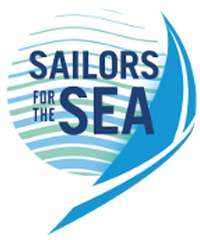 Sailors For The Sea: Be the change you want to sea.
Sailors For The Sea: Be the change you want to sea.
 The Grantham Foundation for the Protection of the Environment: Committed to protecting and improving the health of the global environment.
The Grantham Foundation for the Protection of the Environment: Committed to protecting and improving the health of the global environment.
 Contribute to Living on Earth and receive, as our gift to you, an archival print of one of Mark Seth Lender's extraordinary wildlife photographs. Follow the link to see Mark's current collection of photographs.
Contribute to Living on Earth and receive, as our gift to you, an archival print of one of Mark Seth Lender's extraordinary wildlife photographs. Follow the link to see Mark's current collection of photographs.
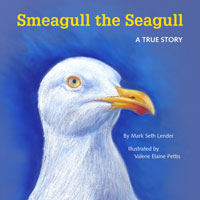 Buy a signed copy of Mark Seth Lender's book Smeagull the Seagull & support Living on Earth
Buy a signed copy of Mark Seth Lender's book Smeagull the Seagull & support Living on Earth

